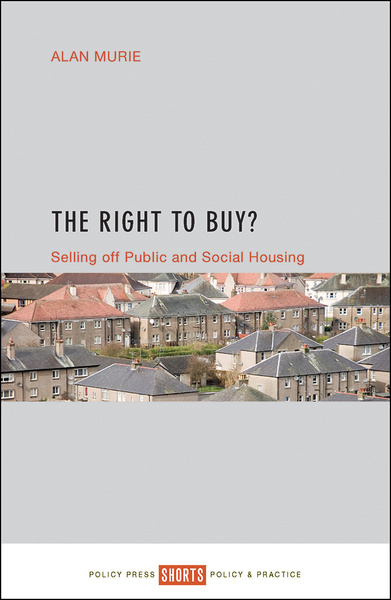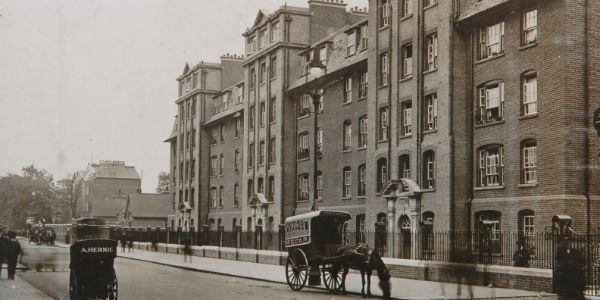Book review: The Right to Buy? Selling off Public and Social Housing, by Alan Murie
Introduced under the Thatcher government, ‘Right to Buy’ has had a formative effect on housing in the UK for the past 35 years. In The Right to Buy? Selling Off Public and Social Housing, Alan Murie examines the policy’s long-standing and ongoing impact, and considers the implications of its more recent extension. While more explicit political analysis of the consequences of ‘Right to Buy’ would have bolstered the book’s arguments, John Picton welcomes this timely, detailed and important read.
The Right to Buy? Selling Off Public and Social Housing. Alan Murie. Policy Press Shorts. 2016
 Following her 1979 election win, Margaret Thatcher proclaimed: ‘Thousands of people in council houses and new towns came out to support us for the first time because they wanted a chance to buy their own homes.’ She correctly gauged the political weather. In the thirty-five years since the introduction of the ‘Right to Buy’, over two million homes have been transferred from public to private hands, and each one at a substantial market discount.
Following her 1979 election win, Margaret Thatcher proclaimed: ‘Thousands of people in council houses and new towns came out to support us for the first time because they wanted a chance to buy their own homes.’ She correctly gauged the political weather. In the thirty-five years since the introduction of the ‘Right to Buy’, over two million homes have been transferred from public to private hands, and each one at a substantial market discount.
In The Right to Buy? Selling Off Public and Social Housing, Alan Murie assesses the impact of the decades-old policy, which had been intended to increase national home ownership. It is a story of winners and losers. Some tenants greatly profited. Judged by the volume of sales, the policy was an unambiguous triumph, marking – in the short term – a giant national leap towards property-owning democracy. Yet collective losses have also been borne across the generations. Where a baby boomer parent gained an asset, their children lost access to social rents.
The most attractive homes sold quickest, making big winners out of the early purchasers. But almost every buyer received a windfall. While flats and maisonettes were slower to sell, they were subject to very high discounts: up to 70 per cent of the market value. Right to Buy transferred public property directly to individual tenants, and in this regard, it is crucial to note the focused and positive impact that the policy had on individual lives and aspirations.
But the collective cost has been a high one. The best properties are now well out of the reach of lower income people: semi-detached houses with gardens fetch extremely high prices. And so large classes of people have become excluded from once-accessible suburbs. The privatisation of our housing stock has led to our segregation.
Even if segregation is intuitively undesirable, it is not a body blow to the rationale behind the policy. The project was concerned with increasing home ownership, not demographic equality. But the slow revival of private renting crashes the kite. Many properties have now been sold on to landlords, whose tenants pay market rent. Speculators might buy properties and convert them, putting stress on stock designed for smaller numbers. Rather than delivering a property-owning democracy, private landlordism will increase over time. By definition, speculators have an advantage in the marketplace.
In different political circumstances, that might have been the end of the book. Council housing has now been largely sold off, and so at one time the Right to Buy seemed likely to pass slowly into the national memory, felt only in an increasing housing benefit bill. But it is said that history repeats itself: during the 2015 general election, David Cameron revived the scheme, promising and then delivering a new Right to Buy in relation to housing association stock in England and Wales.
This extension of the right gives the author’s analysis a pressing purchase. He charts the seldom-told history of housing associations, explaining how, through rebellion in the House of Lords, associations escaped the Right to Buy in the 1980s. And Murie also explains that, over the course of a generation, councils have transferred large amounts of their stock to the sector, so that in our own time associations have become by far the largest type of social housing provider.

The Peabody estate in Fulham, built in 1912, was social housing. Photo: PeabodyLDN via a CC BY 2.0 licence
In contrast to the original public sector sales, this time around there is a mechanism to provide for replacement. Housing associations will maintain their stock, drawing compensation from the government. In the spirit of our age, it is a complex and managerialist plan: to pay for the new Right to Buy, local authorities will be forced to sell ‘higher value’ properties as they fall vacant. After rebuilding, they will transfer any surplus into the new scheme, and so fund the housing association Right to Buy.
Rebuilding and replacement laces the pill; but the social impact will still be real enough. Following the pattern of the past, sales of association housing will be quickest in high value areas, further accelerating our segregation. It is also unclear how associations will respond to their new market position. Following the forced sales of historic estates, it would be rational for them to abandon their missions, leaving the poorest tenants to the market.
Feelings run high with regard to this area of policy, and Murie remains objective throughout. He explains the facts and weighs the evidence. He then concludes that government strategy has failed, and that it will fail again. The book provides a detailed, and welcome, analysis of the subject matter. However, the author’s objectivity perhaps comes at the cost of political analysis.
Such analysis would wade out into difficult waters, and the book largely keeps its feet dry. Yet without an understanding of government motivation, it is not possible to see why any alternative to the policy is so unlikely. The Right to Buy, along with other state sell-offs, has marked a seismic shift in the government’s relationship to the population. Criticisms relating to social segregation, landlordism and the abandonment of large numbers to the market only bite if it is assumed that policymakers care about collective welfare.
The author acknowledges that the new Right to Buy was forged from political exigency in the context of the 2015 election campaign. The new Right to Buy will impact on as many as 800,000 social tenants. The electoral advantage in offering discounts to this population is obvious. But from the perspective of conservative social policymakers, it is surely short-sighted. If over the course of the next generation rising private sector landlordism negatively affects the lives of many, the resulting political consequences are unlikely to be support for more of their particular brand of technocracy.
The Right to Buy? Selling Off Public and Social Housing is timely. The extension of the right to housing associations makes this analysis very important indeed. In the context of fast-moving change, the book provides a welcome and objective policy analysis.
This post represents the views of the author and not those of Democratic Audit. It was first published at the LSE Review of Books.
Dr John Picton is Lecturer in Law at the University of Liverpool, where he is a member of the Charity Law and Policy Unit. He tweets @JohnPicton5





 Democratic Audit's core funding is provided by the Joseph Rowntree Charitable Trust. Additional funding is provided by the London School of Economics.
Democratic Audit's core funding is provided by the Joseph Rowntree Charitable Trust. Additional funding is provided by the London School of Economics.
Book review: The Right to Buy? Selling off Public and Social #housing #social #socialhousing https://t.co/PWCpALvgaL https://t.co/7qXzjAzDax
Book review: The Right to Buy? Selling off Public and Social Housing, by Alan Murie https://t.co/oJ66yFNaL4
Right to buy or cheap modern housing?
The planning system puts a straight jacket on the housing market forcing housing prices to unfair levels taking for the young and the poor and giving to the rich. I downloaded the Land Registry data on house prices and filtered them by the geodemographic classification P2 People and Places (1). Between 2000 and 2010, the wealthiest group in the classification had their house prices rise by an average of 8 times the average earned income in 2010. For the least wealthy group it was 2 times.(2)
According to the 2011 census, nearly all the wealthiest group owned their houses. Few of the least wealthy did. The housing market has divided the country into two groups: those that own houses and those that do not.
If we could neuter the political effect of the NIMBYs and break the land banks, the planning system could be reformed to allow £20k starter homes – quite possible with modern prefab construction.(3)
I find it strange that this Government may be edging towards a similar policy: Plotlands and Prefabs (4). This entails house ready plots on which to put modern prefabs, which could lower the cost of housing dramatically. This may be a smoke screen and the NIMBYs, land owners and land bankers may continue to cash in but if this policy were allowed to shake the housing market, the powerful “politcal weather” of home ownership would make it irreversible.
With cheap housing flooding the market, ‘Right to Buy’ would become a political side show.
(1) https://p2peopleandplaces.co.uk/
(2) The house prices were adjusted for inflation.
(3) https://bkuk.com/housing/index.html
(4 )https://www.brusselsblog.co.uk/will-the-government-restart-plotlands/
P.S. As a Labour Party member I groaned when I found out that John Healey appointed the CEO of Taylor Wimpey to solve the housing problem. Could he actually recommend flooding the market with cheap housing?
Book review: The Right to Buy? Selling off Public and Social Housing, by Alan Murie https://t.co/N1XYyhYQ0E https://t.co/9xWXobFSOv